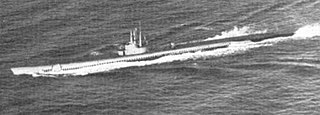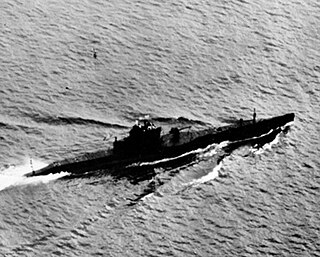
USS Arnold J. Isbell (DD-869), a Gearing-class destroyer, was the only ship of the United States Navy to be named for Arnold J. Isbell, an aircraft carrier captain during World War II. The ship was laid down on 14 March 1945 at Staten Island, New York, by Bethlehem Mariners Harbor, launched on 6 August 1945 and commissioned on 5 January 1946. Constructed too late to see action in World War II, the vessel initially served as a training ship with the United States Atlantic Fleet, before transferring to the Pacific and deploying to Korea during the Korean War and off the Vietnam coast during the Vietnam War. In 1972 Arnold J. Isbell was made part of the reserve training fleet and in 1974, sold to Greece where the ship was renamed Satchouris and served with the Hellenic Navy until being sold for scrap in 2002.

USS Salmon (SSR/SS/AGSS-573), a Sailfish-class submarine, was the third ship of the United States Navy to be named for the salmon.

USS Runner (SS/AGSS-476), a Tench-class submarine, was the second ship of the United States Navy to be named for the runner, an amberfish inhabiting subtropical waters.

USS Volador (SS-490), a Tench-class submarine, was the second ship of the United States Navy to be named for the volador. The contract to build her was awarded to Portsmouth Naval Shipyard in Kittery, Maine, and her keel was laid down on 15 June 1945, but work on her construction was discontinued in January 1946. Her unfinished hulk remained on the ways until August 1947 when construction resumed, now including GUPPY II enhancements to the basic Tench design. Volador was launched on 21 May 1948 sponsored by Mrs. Harriet Rose Morton widow of Commander Dudley W. Morton, and commissioned on 1 October 1948, with Lieutenant Commander Howard A. Thompson in command.

USS Sea Leopard (SS-483), a Tench-class submarine, was the only ship of the United States Navy to be named for the leopard seal. Her keel was laid down by the Portsmouth Navy Yard on 7 November 1944. She was launched on 2 March 1945 sponsored by Hon. Margaret Chase Smith, United States Congresswoman from Maine, and commissioned on 11 June 1945.

USS Bugara (SS-331), a Balao-class submarine, was a ship of the United States Navy named for the bugara, a multicolored fish found along the coast of California.

USS Jallao (SS-368), a Balao-class submarine, was a ship of the United States Navy named for the jallao, a pearl-white haemulonid food fish of the Gulf of Mexico.

USS Sea Owl (SS/AGSS-405), a Balao-class submarine, was a ship of the United States Navy named for the sea owl, a lumpfish of the North Atlantic Ocean.

USS Sea Fox (SS-402), a Balao-class submarine, was a vessel of the United States Navy named for the sea fox, a large shark, also called the thresher shark, which frequents the coast of Europe and the Americas.

USS Tiru (SS-416), a Balao-class submarine, was a vessel of the United States Navy named for the tiru, a member of the lizardfish family.

USS S-31 (SS-136) was a first-group S-class submarine of the United States Navy.

USS Naifeh (DE-352) was a John C. Butler-class destroyer escort in service with the United States Navy from 1944 to 1960. She was sunk as a target in 1966.

USS Hambleton (DD-455/DMS-20) was a Gleaves-class destroyer of the United States Navy, named for Purser Samuel Hambleton (1777–1851).

USS Craven (DD-382) was a Gridley-class destroyer commissioned in the United States Navy from 1937 to 1946. She served in the Pacific War and was scrapped in 1947.

USS Walton (DE-361) was a John C. Butler-class destroyer escort in the United States Navy. It was named after Merrit Cecil Walton, a Marine Corps platoon sergeant with the U.S. 1st Marine Division, who died on Gavutu during the Battle of Guadalcanal and was posthumously awarded the Navy Cross for "extraordinary heroism".

USS Hollister (DD-788) was a Gearing-class destroyer of the United States Navy, named for the three Hollister brothers, who were killed in 1943 while serving in the Navy during World War II.

The third USS Keppler (DD/DDE-765) was a Gearing-class destroyer in the United States Navy during the Korean War and the Vietnam War. She was named for Boatswain's Mate First Class Reinhardt J. Keppler (1918–1942), who was posthumously awarded the Medal of Honor for "extraordinary heroism" during the Naval Battle of Guadalcanal.

USS Ulvert M. Moore (DE-442) was a John C. Butler-class destroyer escort acquired by the U.S. Navy during World War II. The primary purpose of the destroyer escort was to escort and protect ships in convoy, in addition to other tasks as assigned, such as patrol or radar picket. Post-war she returned home bearing five battle stars; when she was reactivated for the Korean War, she returned home after that war with three more.

USS Hanna (DE-449) was a John C. Butler-class destroyer escort acquired by the U.S. Navy during World War II. The primary purpose of the destroyer escort was to escort and protect ships in convoy, in addition to other tasks as assigned, such as patrol or radar picket. She returned home with five battle stars to her credit after she was reactivated for Korean War duty.

USS Ruchamkin (APD-89), ex-DE-228, later LPR-89, was a United States Navy high-speed transport in commission from 1945 to 1946, from 1951 to 1957, and from 1961 to 1969. She subsequently served as ARC Córdoba in the Colombian Navy, until 1980; although scrapped, her hull and superstructure were re-erected in a leisure park near Bogotá.




















